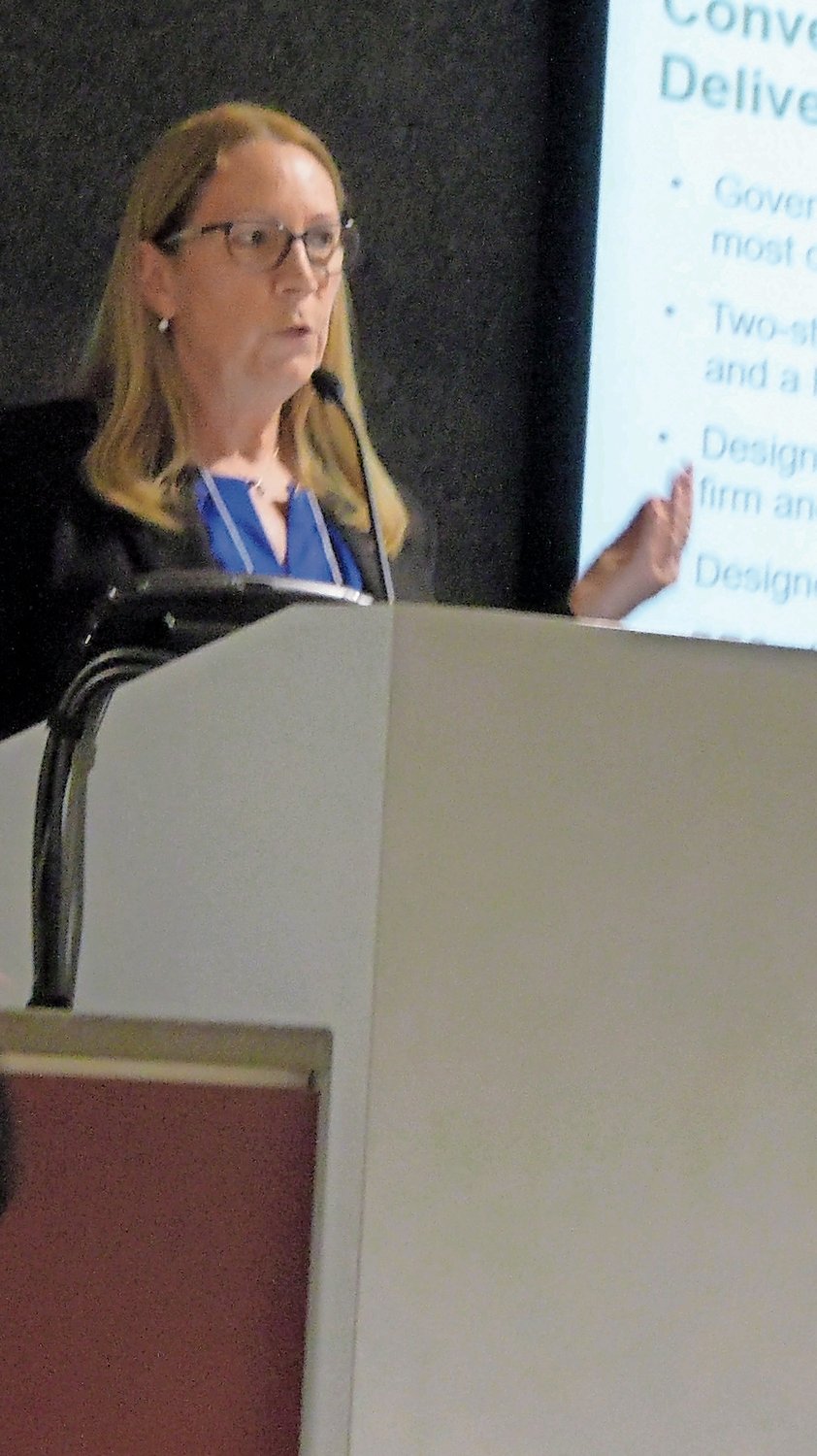New pipeline to help stabilize marsh islands
The Bay Park Conveyance project took a big step forward on Feb. 25, as managers described the project’s current scope and gave community stakeholders their first public opportunity to comment on the project and the likely need to invoke eminent domain.
The $400 million project will redirect roughly 55 million gallons of treated wastewater daily from the Bay Park Sewage Treatment Plant to the Cedar Creek Water Pollution Control Plant, in Wantagh, via roughly 11 miles of new pipeline. From there, the treated effluent will be pumped seven miles from Cedar Creek, including three miles of underwater pipeline, into the Atlantic Ocean, after having more than 99 percent of its nitrogen removed.
Funding for the project will come from state and federal grants and Nassau County bonds.
Administrative Law Judge James McClymonds presided over the Feb. 25 hearing, which was hosted by Bay Park Project Director Susan McCormick of the state Department of Environmental Conservation. The DEC is coordinating the efforts of more than a half-dozen federal, state and county agencies. The conveyance is slated for completion by October 2022.
Nitrogen-rich effluent causes the marsh islands in the Western Bays to erode as seawater washes over them at high tide. The islands are essential for protection from storms like Hurricane Sandy, which devastated Nassau’s South Shore, McCormick said. Eliminating nitrogen enables the islands to rejuvenate themselves.
The project will use a “design-build” delivery method, in which the project is built as each phase of the design is completed. “Normally, construction wouldn’t begin until the design phase for the whole project was completed,” McCormick explained. “Using that approach, the project could’ve taken as long as 10 years to finish.”
The DEC sent out a request for qualifications last fall, and expects to ask three respondents to submit proposals in the next few weeks. Initially, project managers hoped to complete the process of selecting a design-build team, as well as any environmental reviews, by October. Now, McCormick said, “We’ll probably break ground next spring. That’ll give us a little more time for the review process.”
The project will have three components. The first will be a two-mile force main from Bay Park to Sunrise Highway. From there, a 7.3-mile stretch of a 100-year-old aqueduct, once used to bring drinking water to the area from Brooklyn, will be repurposed. The aqueduct will connect to Cedar Creek via a second force main 1.6 miles long.
From Cedar Creek, the treated effluent will be pumped seven miles: first, through four miles of underground pipes; and finally, through three miles underwater pipe, taking the wastewater to a perpendicular, one-mile-long dispersal pipe offshore, with outflows along its length. “They’ll be sort of like fountains,” McCormick said. “Otherwise, you’d have one huge gusher of water shooting up into the air.”
New or upgraded pump stations will be built in both Bay Park and Cedar Creek, McCormick said.
The aqueduct, which is still structurally sound despite its age, runs down the median of Sunrise Highway. A new, 60-inch pipe will be installed inside it in a process called slip-lining.
The pipelines for the two sections of force mains will be laid using micro-tunneling technology. The tunnels will be at a depth of 40 to 70 feet, depending on the subsurface conditions encountered during construction, and various tunnel alignments have been identified to minimize impact on residential and commercial property.
“As much as possible, we’ll route the tunnels along rights-of-way and public land,” McCormick said.
The biggest piece of the project — slip-lining the Sunrise Highway aqueduct — will be more complicated. Work will be done mainly at night and on weekends, but some inconvenience is inevitable. Asked if the construction would disturb traffic along the route, McCormick said, “Yes.” The aim is to complete the work as quickly and painlessly as possible, but, she added, “We’ll be working in the middle of Sunrise Highway. There’s no way to avoid some disruption.”
The work along Sunrise will be divided into 23 zones, McCormick said, and no more than five zones will be active at one time.
Inevitably for a project of this magnitude, some easements will be needed. To that end, letters were sent to property owners along the proposed construction routes. Homeowners will be asked only for subsurface easements that are at least 30 feet underground, McCormick said.
At the conclusion of the presentation, audience members were invited to submit comments. Rockville Centre Mayor Francis X. Murray said he had met with Gov. Andrew Cuomo a year ago to discuss the project, which he endorsed.
Kyle Rabin, of the Long Island Regional Planning Council, echoed Murray’s support. “This project will be a real game changer,” Rabin said, adding that even without storms, nitrogen from effluent causes algae blooms that are a danger to marine life and an impediment to human enjoyment of the shoreline.
Dr. David Stern, a civil engineer and professor at Nassau Community College, sounded the only note of caution. While generally supporting the project — or something similar — he urged the partners to consider a different route. A second existing aqueduct could send treated water to the headwaters of the Mill River at Lake Hempstead, freeing the aqueduct beneath Sunrise Highway to be used to bring drinking water from New York City reservoirs, like the one in Croton Falls.
“I came here tonight to request that you expand your thinking, to consider the longer-term needs of Nassau County residents,” Stern read from a prepared statement. “The Grumman plume is causing havoc in the drinking water wells of the down-gradient. The southwest of the county is experiencing saltwater intrusion. … We are now living in the ‘age of consequences.’”
Stern said that the cost of buying drinking water from New York City would be considerably less than the cost of keeping Nassau County’s surface wells pollution-free

 44.0°,
Mostly Cloudy
44.0°,
Mostly Cloudy 





